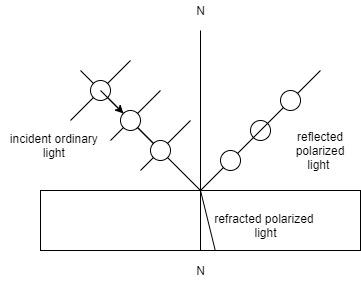
What is polarization of light? Explain polarization of light with the suitable diagram and hence derive Brewster’s law.
Answer
549k+ views
Hint: Brewster’s law states that when light from a medium enters a medium of another medium such that the refractive index one is different from another, it gets polarized. This results in production of two rays i.e. refracted ray and reflected ray which are perpendicular to each other. This occurs when angle of incidence has a certain value called the Brewster’s angle.
Complete step by step solution:

In this figure, it can be seen that an incident unpolarized ray of light breaks down into a refracted ray of light and a reflected ray of light.
Let the refractive index of medium 1 is ${n_1}$ and that of medium 2 is ${n_2}$ . Using Snell’s law,
${n_i}\sin {\theta _i} = {n_r}\sin {\theta _r}.........(1)$ where ${\theta _i}\& {\theta _r}$ are the angle of incidence and angle of refraction respectively.
Brewster’s angle is denoted by ${\theta _B}$ and angle of reflection by ${\theta _r}$ .
We know ${\theta _i} = {\theta _{refl}}$
$\therefore $ $(1)$ becomes ${n_1}\sin {\theta _B} = {n_2}\sin {\theta _r}$
$ \Rightarrow \sin {\theta _r} = \dfrac{{{n_1}}}{{{n_2}}}\sin {\theta _B}.............(2)$
Consider the figure,
$\Rightarrow{\theta _{ref}} + {90^0} + {\theta _r} = {180^o}$ (Angle of straight line)
$ \Rightarrow {\theta _r} = {90^0} - {\theta _{ref}}............(3)$
$(3)$ can be written as ${\theta _r} = {90^0} - {\theta _B}$............$(4)$
because ${\theta _i} = {\theta _{refl}}$
Using $(2)\& (4)$ ,
$\Rightarrow \sin ({90^0} - {\theta _B}) = \dfrac{{{n_1}}}{{{n_2}}}\sin {\theta _B}$
$\therefore \cos {\theta _B} = \dfrac{{{n_1}}}{{{n_2}}}\sin {\theta _B}$ as $\sin ({90^0} - \theta ) = \cos \theta $
$\therefore \dfrac{{{n_2}}}{{{n_1}}} = \dfrac{{\sin {\theta _B}}}{{\cos {\theta _B}}} = \tan {\theta _B}$ as $\dfrac{{\sin \theta }}{{\cos \theta }} = \tan \theta $
$\therefore {n_{21}} = \tan {\theta _B}$ where ${{{n}}_{21}}$ is refractive index of medium $2$ with respect to medium $1$
Note: Refractive index of a medium with respect to another one depends on both the medium and hence when one medium is replaced by another, the Brewster’s angle also changes.
Using inverse trigonometry, we can directly evaluate the Brewster’s angle as
${\theta _B} = {\tan ^{ - 1}}({n_{21}})$
Complete step by step solution:

In this figure, it can be seen that an incident unpolarized ray of light breaks down into a refracted ray of light and a reflected ray of light.
Let the refractive index of medium 1 is ${n_1}$ and that of medium 2 is ${n_2}$ . Using Snell’s law,
${n_i}\sin {\theta _i} = {n_r}\sin {\theta _r}.........(1)$ where ${\theta _i}\& {\theta _r}$ are the angle of incidence and angle of refraction respectively.
Brewster’s angle is denoted by ${\theta _B}$ and angle of reflection by ${\theta _r}$ .
We know ${\theta _i} = {\theta _{refl}}$
$\therefore $ $(1)$ becomes ${n_1}\sin {\theta _B} = {n_2}\sin {\theta _r}$
$ \Rightarrow \sin {\theta _r} = \dfrac{{{n_1}}}{{{n_2}}}\sin {\theta _B}.............(2)$
Consider the figure,
$\Rightarrow{\theta _{ref}} + {90^0} + {\theta _r} = {180^o}$ (Angle of straight line)
$ \Rightarrow {\theta _r} = {90^0} - {\theta _{ref}}............(3)$
$(3)$ can be written as ${\theta _r} = {90^0} - {\theta _B}$............$(4)$
because ${\theta _i} = {\theta _{refl}}$
Using $(2)\& (4)$ ,
$\Rightarrow \sin ({90^0} - {\theta _B}) = \dfrac{{{n_1}}}{{{n_2}}}\sin {\theta _B}$
$\therefore \cos {\theta _B} = \dfrac{{{n_1}}}{{{n_2}}}\sin {\theta _B}$ as $\sin ({90^0} - \theta ) = \cos \theta $
$\therefore \dfrac{{{n_2}}}{{{n_1}}} = \dfrac{{\sin {\theta _B}}}{{\cos {\theta _B}}} = \tan {\theta _B}$ as $\dfrac{{\sin \theta }}{{\cos \theta }} = \tan \theta $
$\therefore {n_{21}} = \tan {\theta _B}$ where ${{{n}}_{21}}$ is refractive index of medium $2$ with respect to medium $1$
Note: Refractive index of a medium with respect to another one depends on both the medium and hence when one medium is replaced by another, the Brewster’s angle also changes.
Using inverse trigonometry, we can directly evaluate the Brewster’s angle as
${\theta _B} = {\tan ^{ - 1}}({n_{21}})$
Recently Updated Pages
Basicity of sulphurous acid and sulphuric acid are

Master Class 12 Business Studies: Engaging Questions & Answers for Success

Master Class 12 Economics: Engaging Questions & Answers for Success

Master Class 12 English: Engaging Questions & Answers for Success

Master Class 12 Maths: Engaging Questions & Answers for Success

Master Class 12 Social Science: Engaging Questions & Answers for Success

Trending doubts
What are the major means of transport Explain each class 12 social science CBSE

Which are the Top 10 Largest Countries of the World?

Draw a labelled sketch of the human eye class 12 physics CBSE

How much time does it take to bleed after eating p class 12 biology CBSE

Explain sex determination in humans with line diag class 12 biology CBSE

Differentiate between homogeneous and heterogeneous class 12 chemistry CBSE




